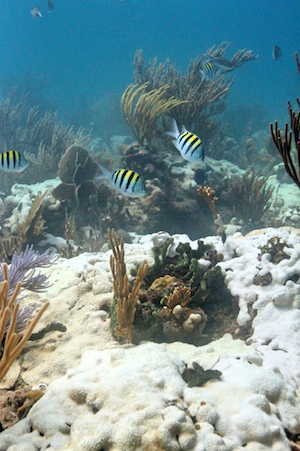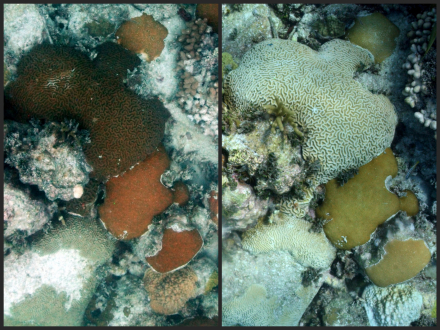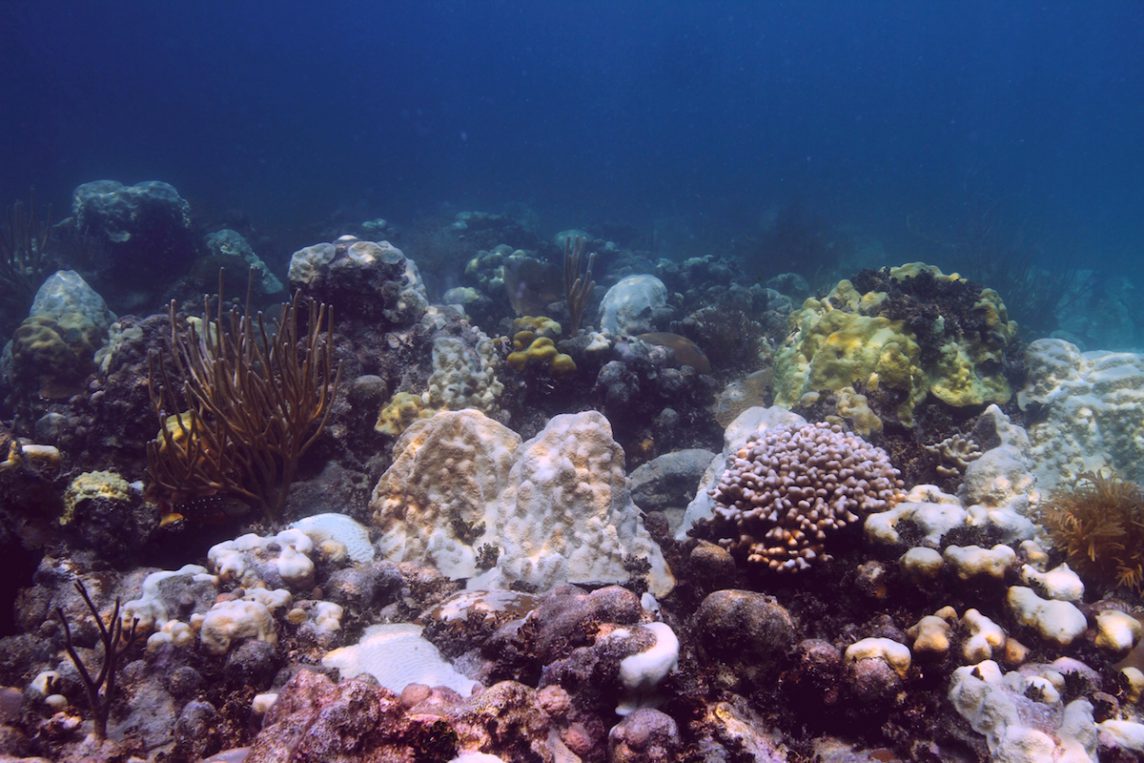For the third time in recorded history, a massive coral bleaching event is unfolding throughout the world’s oceans, stretching from the Indian Ocean to the Caribbean. Above average sea surface temperatures exacerbated by a strong El Niño could result in the planet losing up to 4,500 square miles of coral this year alone, according to NOAA. The global event is predicted to continue to impact reefs into the spring of 2016.
AOML Selects Coral Researcher, Jim Hendee, to Lead Ocean Chemistry & Ecosystems Research
 AOML is proud to announce the selection of Dr. James “Jim” Hendee as the director of its Ocean Chemistry and Ecosystems Division. Internationally recognized for his expertise in coral observing systems and data management, Jim’s almost 25-year tenure with AOML began in 1990 as a data manager for several ocean chemistry programs. Jim is well known for his ability to leverage resources to innovatively develop and inspire productive research teams. Jim steps into the role of director after serving in an acting capacity since June 2013.
AOML is proud to announce the selection of Dr. James “Jim” Hendee as the director of its Ocean Chemistry and Ecosystems Division. Internationally recognized for his expertise in coral observing systems and data management, Jim’s almost 25-year tenure with AOML began in 1990 as a data manager for several ocean chemistry programs. Jim is well known for his ability to leverage resources to innovatively develop and inspire productive research teams. Jim steps into the role of director after serving in an acting capacity since June 2013.
Jim’s early career at AOML blossomed as he oversaw data management of the newly established SEAKEYS program, a network of lighthouses and other platforms that collect hourly in situ sea temperature and meteorological data at coral reef sites along the Florida Keys. Jim initially gathered SEAKEYS data and distributed it daily via fax (“Coral Fax”) to environmental managers in the Florida Keys, as well as to dive boat and fishing charters. Seeing an opportunity to embrace emerging technology and the burgeoning Internet, Jim successfully launched the “Coral Health and Monitoring Program” (CHAMP) to start the very first coral reef related Web page, and one of the first 3,000 Web sites in the world. The server was also used to host a list-server called Coral-List with about 100 names taken from the attendee list for the 8th International Coral Reef Symposium in Panama. That list still operates today with over 8,500 subscribers and has become the de facto means of broad communication among coral reef researchers the world over.
In 1998 Jim was chosen as one of the members of the newly established U.S. Coral Reef Task Force Monitoring Working Group. Jim and his growing team of NOAA oceanographers eventually devised a new design for in situ coral reef monitoring and began installing the design at coral reef sites in the Caribbean, with funding help from NOAA’s newly formed Coral Reef Conservation Program.
Through the years the CHAMP program has received over $8 million for coral reef research and to develop the expert system that is the heart of the CREWS ecological forecasting system. Jim’s efforts have supported acquisition of an appreciable amount of computing hardware and software, oceanographic and meteorological instrumentation, and supported five major international workshops. Jim also leverages the continuing CHAMP funds to establish and support new research directions (e.g., ocean acidification, ecological forecasting, physical oceanography of coral reefs) and personnel support for research scientists and system administrators, five National Research Council post-docs, and numerous Hollings Scholars and student interns.
From 1993 to 2000, Jim worked nights to earn a Ph.D. in Information Systems from Nova Southeastern University. His previous degrees include a B.S. and M.S. in marine biology. In 2000, Jim received the NOAA Research Employee of the Year award, and in 2005 the NOAA Bronze medal for establishing the CREWS Network.
Originally Published in February 2015 by Shannon Jones
The Science Behind Coral Bleaching in the Florida Keys

Photograph of bleached pillar coral on November 13, 2014 at Sand Key. Image credit: NOAA’s Florida Keys National Marine Sanctuary.
2014 was a relatively warm summer in South Florida, and local divers noticed the effects of this sustained weather pattern. Below the ocean surface, corals were bleaching. In the month of August, the Coral Bleaching Early Warning Network, jointly supported by Mote Marine Lab and NOAA’s Florida Keys National Marine Sanctuary, received 34 reports describing paling or partial bleaching and an additional 19 reports indicating significant bleaching. Scientists continue to monitor the impact of this severe bleaching event to determine the extent of coral mortality.
This image, taken on November 13, 2014 by the Florida Keys National Marine Sanctuary, shows a severely bleached pillar coral at Sand Key in the Florida Keys. Images like this one indicate that some regions and species will definitely be affected. Pillar coral is one of the species of coral listed as threatened under the Endangered Species Act.
AOML Coral Ecologists Derek Manzello and Jim Hendee provide insight as to how the environmental conditions they are tracking indicate that a mass bleaching event is possible and even likely in the Florida Keys.
What is coral bleaching?
Coral colonies are made up of hundreds or even thousands of genetically identical individuals called polyps. These polyps have microscopic colorful algae called zooxanthellae living within their tissues. The zooxanthellae work like an internal symbiotic vegetable garden, carrying out photosynthesis and providing energy to their coral hosts, which helps reef-building corals create reef structures. When a coral bleaches, it expels its zooxanthellae, and can die within a matter of weeks unless the zooxanthellae populations are able to recover. The term bleaching is used because the dazzling colors of living corals are due to the zooxanthellae in coral tissue, and when zooxanthellae are lost, corals appear white, or “bleached.”

Extensive bleaching of the soft coral Palythoa caribaeorum on Emerald Reef, Key Biscayne, Fl. (Credit:NOAA)
What causes coral bleaching?
It is well established that elevated sea temperatures cause widespread coral bleaching. Warmer waters “stress” corals and trigger coral bleaching.
There are two types of heat stress that can trigger bleaching: (1) short-term, acute temperature stress (several days of very high water temperatures) and, (2) cumulative temperature stress (weeks of consistent moderately elevated water temperatures). Scientists have documented that coral communities around the world have different heat stress thresholds that typically trigger bleaching in response to heat stress. Scientists rely on long-term observing stations co-located with coral reefs to identify the specific conditions that correlate to bleaching within different regions.
What specifically triggers bleaching of coral found in the FL Keys?
Using long-term in situ datasets such as the Coastal-Marine Automated Network, or C-MAN, stations in the Florida Keys, AOML scientists identified specific patterns of warm waters on coral reefs that tend to precede bleaching
events. The indices that proved to be the most reliable indicators for bleaching for the Florida Reef Tract are maximum monthly sea surface temperature and the number of days >30.5 C (86.9 F).
What patterns have scientists noticed leading up to this most recent bleaching event?
Data from the Molasses Reef C-MAN station showed that the winter of 2014 was the warmest on record since these stations began recording data in 1988. The second warmest winter on record was the winter of 1996/97, which preceded back-to-back bleaching years in the Keys (1997/98) and was the worst bleaching event ever documented in the Florida Keys. The most recent significant bleaching event in the Florida Keys occurred in 2005, and there have been mild localized bleaching events since then.

The images above were taken from a coral colony at Cheeca Rocks in the Florida Keys. On the left shows the coral colony from July 2013. The image at the right shows the same coral colony in August 2014, with the colony now bleached. (Credit: NOAA)
The warm winter and warm water temperatures this spring caused scientists to start watching the long-term average water temperatures at these stations to see if the average daily temp was regularly reaching or exceeding 30.4 C, the trigger point for previous bleaching in the FL Keys. The Molasses Reef C-MAN site quickly approached this temperature threshold in July and August. Average temperatures were also warmer than normal at the Fowey Rocks C-MAN station and the Cheeca Rocks Atlantic Ocean Acidification Testbed in the northern Keys. With water temperatures now exceeding this threshold for more than thirty days, and reports of bleaching beginning to pour in, there are concerns about widespread bleaching throughout the region. To assess the extent of the bleaching event, Florida Keys National Marine Sanctuary has been working with its partners to monitor the current state of corals along the reef tract.
Jim Hendee is the acting division director of AOML’s Ocean Chemistry and Ecosystems Division. Jim leads the coral group at AOML and studies the environmental conditions that cause ecosystem-wide changes on coral reefs using in situ observing stations. Derek Manzello is a coral ecologist at AOML and leads research of the impacts of ocean acidification on coral reefs. Derek also studies the impact of other changes in environmental conditions on reefs such as temperature and tropical storm impacts.
Originally Published September 2014 by Shannon Jones
